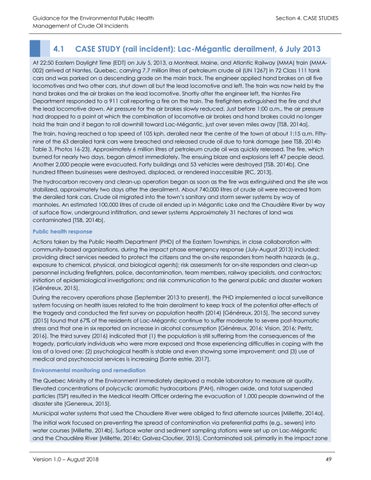Guidance for the Environmental Public Health Management of Crude Oil Incidents
4.1
Section 4. CASE STUDIES
CASE STUDY (rail incident): Lac-Mégantic derailment, 6 July 2013
At 22:50 Eastern Daylight Time (EDT) on July 5, 2013, a Montreal, Maine, and Atlantic Railway (MMA) train (MMA002) arrived at Nantes, Quebec, carrying 7.7 million litres of petroleum crude oil (UN 1267) in 72 Class 111 tank cars and was parked on a descending grade on the main track. The engineer applied hand brakes on all five locomotives and two other cars, shut down all but the lead locomotive and left. The train was now held by the hand brakes and the air brakes on the lead locomotive. Shortly after the engineer left, the Nantes Fire Department responded to a 911 call reporting a fire on the train. The firefighters extinguished the fire and shut the lead locomotive down. Air pressure for the air brakes slowly reduced. Just before 1:00 a.m., the air pressure had dropped to a point at which the combination of locomotive air brakes and hand brakes could no longer hold the train and it began to roll downhill toward Lac-Mégantic, just over seven miles away [TSB, 2014a]. The train, having reached a top speed of 105 kph, derailed near the centre of the town at about 1:15 a.m. Fiftynine of the 63 derailed tank cars were breached and released crude oil due to tank damage (see TSB, 2014b Table 3, Photos 16-23). Approximately 6 million litres of petroleum crude oil was quickly released. The fire, which burned for nearly two days, began almost immediately. The ensuing blaze and explosions left 47 people dead. Another 2,000 people were evacuated. Forty buildings and 53 vehicles were destroyed [TSB, 2014b]. One hundred fifteen businesses were destroyed, displaced, or rendered inaccessible [RC, 2013]. The hydrocarbon recovery and clean-up operation began as soon as the fire was extinguished and the site was stabilized, approximately two days after the derailment. About 740,000 litres of crude oil were recovered from the derailed tank cars. Crude oil migrated into the town’s sanitary and storm sewer systems by way of manholes. An estimated 100,000 litres of crude oil ended up in Mégantic Lake and the Chaudière River by way of surface flow, underground infiltration, and sewer systems Approximately 31 hectares of land was contaminated [TSB, 2014b]. Public health response Actions taken by the Public Health Department (PHD) of the Eastern Townships, in close collaboration with community-based organizations, during the impact phase emergency response (July-August 2013) included: providing direct services needed to protect the citizens and the on-site responders from health hazards (e.g., exposure to chemical, physical, and biological agents); risk assessments for on-site responders and clean-up personnel including firefighters, police, decontamination, team members, railway specialists, and contractors; initiation of epidemiological investigations; and risk communication to the general public and disaster workers [Généreux, 2015]. During the recovery operations phase (September 2013 to present), the PHD implemented a local surveillance system focusing on health issues related to the train derailment to keep track of the potential after-effects of the tragedy and conducted the first survey on population health (2014) [Généreux, 2015]. The second survey (2015) found that 67% of the residents of Lac-Mégantic continue to suffer moderate to severe post-traumatic stress and that one in six reported an increase in alcohol consumption [Généreux, 2016; Vision, 2016; Peritz, 2016]. The third survey (2016) indicated that (1) the population is still suffering from the consequences of the tragedy, particularly individuals who were more exposed and those experiencing difficulties in coping with the loss of a loved one; (2) psychological health is stable and even showing some improvement; and (3) use of medical and psychosocial services is increasing [Sante estrie, 2017]. Environmental monitoring and remediation The Quebec Ministry of the Environment immediately deployed a mobile laboratory to measure air quality. Elevated concentrations of polycyclic aromatic hydrocarbons (PAH), nitrogen oxide, and total suspended particles (TSP) resulted in the Medical Health Officer ordering the evacuation of 1,000 people downwind of the disaster site [Genereux, 2015]. Municipal water systems that used the Chaudiere River were obliged to find alternate sources [Millette, 2014a]. The initial work focused on preventing the spread of contamination via preferential paths (e.g., sewers) into water courses [Millette, 2014b]. Surface water and sediment sampling stations were set up on Lac-Mégantic and the Chaudière River [Millette, 2014b; Galvez-Cloutier, 2015]. Contaminated soil, primarily in the impact zone
Version 1.0 – August 2018
49







